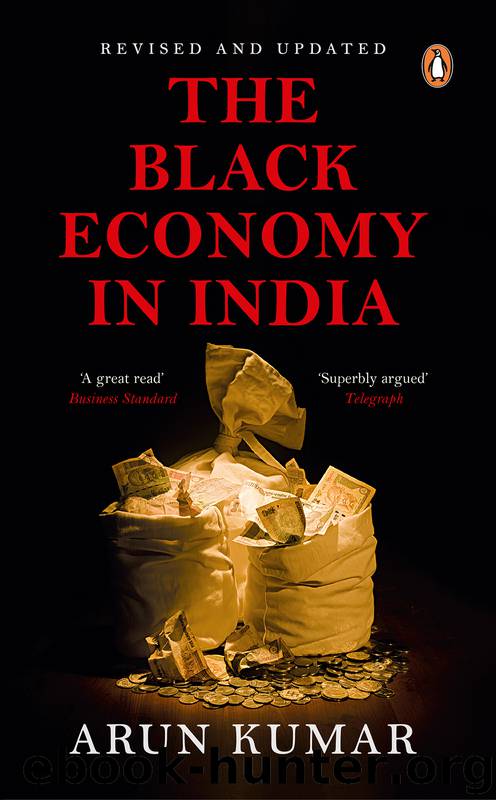The Black Economy in India by Arun Kumar

Author:Arun Kumar
Language: eng
Format: epub
ISBN: 9789387326439
Publisher: Penguin Random House India Private Limited
Published: 2018-02-17T05:00:00+00:00
THE TRIAD
If it is true that it is not so much that politics needs money but that money power needs to control politics for its own ends then democracy would be subverted.
The connivance of the bureaucracy in the functioning of the black economy is a related issue. Its increasing corruption and demoralization need to be understood. The pressures from above (political) are obviously there with sectional interests all too inclined to subvert policy. There are pressures from below as well, as already discussed.
For an illegality to persist in the system, the bureaucracy and the politicians have to actively or passively be a party to it. Hence for the generation of black incomes, the businessman, the politician and the bureaucrat have to be involved. Even if one of the three is missing, there can be no black income generation. This is the triad.
The emergence of the Janata Dal in 1988 was seen as a positive development on the Indian political scene. It was termed as ‘a turning point’ for India. The origins of this event may be traced back to early 1987 when Mr V.P. Singh was abruptly eased out of the Finance Ministry and by mid-1987 out of the Congress party itself.
Mr V.P. Singh’s vigorous campaign against the industrialists, the businessmen and other white-collar crimes had built up a strong lobby against him. In the early days of the Rajiv regime, the campaign against economic crimes did much for his image—‘Mr Clean’ and the ‘government that works’.
Mr V.P. Singh, without being able to check the growing black economy, succeeded in posing a threat to those with large black incomes. He was seen to exceed the limits when Mr Kirloskar and Mr Thapar were arrested. This let loose powerful forces amongst the ‘big business’ lobby which worked for his ouster. Later, these interests worked to dislodge him when he became the prime minister.
Mr Singh tried the carrot of lower tax rates and liberalization of the economic regime while using the stick of the tax raids and arrests. The national dailies howled in protest arguing that the prestige and the image of industrial leaders built over decades ought not to be sullied in this fashion. It was also said that when the private sector is trying to raise massive resources, its image ought not to be tarnished. In other words, the illegality of the rich ought to be tolerated.
Once Mr Rajiv Gandhi’s image had become tarnished by late 1986, Mr V.P. Singh stood out as an alternative. Consequently, Rajiv and the lobbies had a common enemy which needed to be neutralized. Apparently, a rift was created between Mr Rajiv Gandhi and Mr V. P. Singh by creating a suspicion in the former’s mind that the latter was seeking to expose his close friend, Mr Bachchan.
The HDW submarine deal and the Bofors issue burst upon the Indian political scene in quick succession and shook the government. Various other issues of corruption in high places came to light.
Diversions were sought to be created through trying to involve Mr V.
Download
This site does not store any files on its server. We only index and link to content provided by other sites. Please contact the content providers to delete copyright contents if any and email us, we'll remove relevant links or contents immediately.
International Integration of the Brazilian Economy by Elias C. Grivoyannis(74786)
The Radium Girls by Kate Moore(11621)
Turbulence by E. J. Noyes(7700)
Nudge - Improving Decisions about Health, Wealth, and Happiness by Thaler Sunstein(7242)
The Black Swan by Nassim Nicholas Taleb(6764)
Rich Dad Poor Dad by Robert T. Kiyosaki(6175)
Pioneering Portfolio Management by David F. Swensen(6079)
Man-made Catastrophes and Risk Information Concealment by Dmitry Chernov & Didier Sornette(5647)
Zero to One by Peter Thiel(5488)
Secrecy World by Jake Bernstein(4388)
Millionaire: The Philanderer, Gambler, and Duelist Who Invented Modern Finance by Janet Gleeson(4094)
The Age of Surveillance Capitalism by Shoshana Zuboff(3985)
Skin in the Game by Nassim Nicholas Taleb(3965)
The Money Culture by Michael Lewis(3846)
Bullshit Jobs by David Graeber(3830)
Skin in the Game: Hidden Asymmetries in Daily Life by Nassim Nicholas Taleb(3723)
The Dhandho Investor by Mohnish Pabrai(3560)
The Wisdom of Finance by Mihir Desai(3523)
Blockchain Basics by Daniel Drescher(3329)
